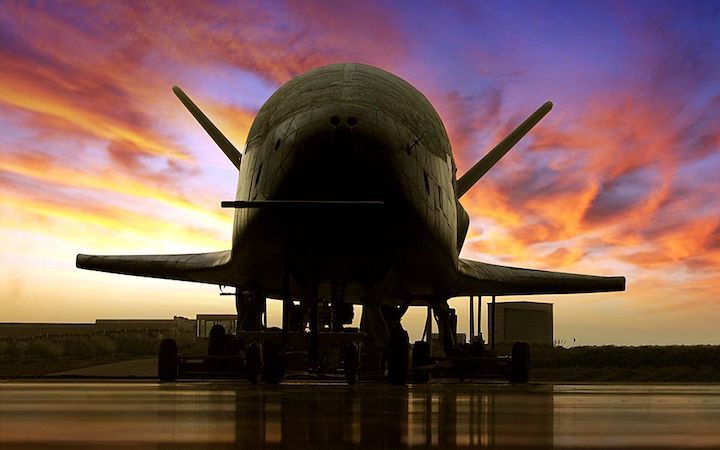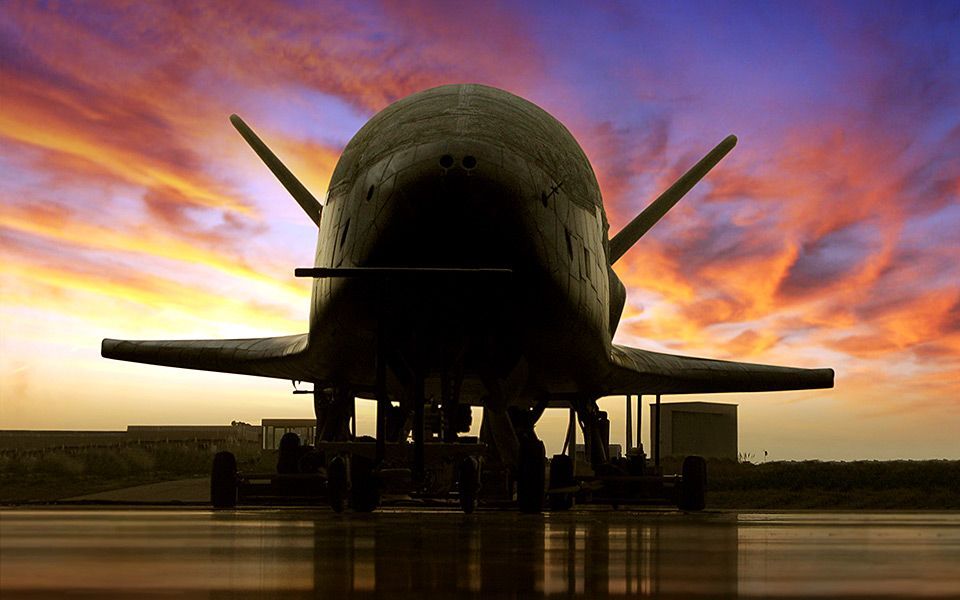KENNEDY SPACE CENTER, Fla., Nov. 12, 2022— The Boeing [NYSE: BA] built X-37B Orbital Test Vehicle (OTV) set a new endurance record after spending 908 days on orbit before landing at NASA’s Kennedy Space Center in Florida at 5:22 a.m. ET, November 12, 2022. This surpasses its previous record of 780 days on-orbit.
With the successful completion of its sixth mission the reusable spaceplane has now flown over 1.3 billion miles and spent a total of 3,774 days in space where it conducts experiments for government and industry partners with the ability to return them to Earth for evaluation.
For the first time, the vehicle carried a service module to augment the number of payloads it can haul. The module separated from the OTV prior to de-orbiting ensuring a safe and successful landing.
“This mission highlights the Space Force's focus on collaboration in space exploration and expanding low-cost access to space for our partners, within and outside of the Department of the Air Force (DAF),” said Gen. Chance Saltzman, Chief of Space Operations.
The sixth mission was launched atop a United Launch Alliance Atlas V rocket from Cape Canaveral Space Force Station in May 2020. Hosted experiments included a solar energy experiment designed by the Naval Research Lab, as well as a satellite designed and built by cadets at the U.S. Air Force Academy in partnership with the Air Force Research Laboratory. The satellite, dubbed FalconSat-8, was successfully deployed in October 2021 and remains on orbit today.
This mission also hosted multiple NASA experiments including the Materials Exposure and Technology Innovation in Space (METIS-2), which evaluated the effects of space exposure on various materials to validate and improve the precision of space environment models. This was the second flight for this type of experiment. Mission 6 also hosted a NASA experiment to evaluate the effects of long-duration space exposure on seeds. This experiment informs research aimed at future interplanetary missions and the establishment of permanent bases in space.
“Since the X-37B’s first launch in 2010, it has shattered records and provided our nation with an unrivaled capability to rapidly test and integrate new space technologies,” said Jim Chilton, senior vice president, Boeing Space and Launch. “With the service module added, this was the most we’ve ever carried to orbit on the X-37B and we’re proud to have been able to prove out this new and flexible capability for the government and its industry partners.”
The X-37B program is a partnership between the U.S Department of the Air Force Rapid Capabilities Office and the U.S. Space Force. Boeing designed and manufactured the spaceplane and continues to provide program management, engineering, test and mission support from sites in Southern California, Florida and Virginia.
In 2020, the X-37B received the Robert J. Collier Trophy for advancing the performance, efficiency and safety of air and space vehicles.
As a leading global aerospace company, Boeing develops, manufactures and services commercial airplanes, defense products and space systems for customers in more than 150 countries. As a top U.S. exporter, the company leverages the talents of a global supplier base to advance economic opportunity, sustainability and community impact. Boeing's diverse team is committed to innovating for the future, leading with sustainability, and cultivating a culture based on the company's core values of safety, quality and integrity.
Quelle: BOEING
----
Update: 14.11.2022
.
Unmanned, solar-powered US space plane back after 908 days
An unmanned U.S. military space plane has landed after spending a record 908 days in orbit for its sixth mission and conducting science experiments

The Boeing-built X-37B Orbital Test Vehicle (OTV) is shown at NASA’s Kennedy Space Center in Florida on Saturday, Nov. 12, 2022. The unmanned U.S. military space plane landed early Saturday after spending a record 908 days in orbit for its sixth mission and conducting science experiments. The solar-powered vehicle, which looks like a miniature space shuttle, landed at NASA’s Kennedy Space Center. Its previous mission lasted 780 days. (Boeing /U.S. Space Force via AP)
CAPE CANAVERAL, Fla. -- An unmanned U.S. military space plane landed early Saturday after spending a record 908 days in orbit for its sixth mission and conducting science experiments.
The solar-powered vehicle, which looks like a miniature space shuttle, landed at NASA’s Kennedy Space Center. Its previous mission lasted 780 days.
“Since the X-37B’s first launch in 2010, it has shattered records and provided our nation with an unrivaled capability to rapidly test and integrate new space technologies,” said Jim Chilton, a senior vice president for Boeing, its developer.
For the first time, the space plane hosted a service module that carried experiments for the Naval Research Laboratory, U.S. Air Force Academy and others. The module separated from the vehicle before de-orbiting to ensure a safe landing.
Among the experiments was a satellite dubbed the FalconSat-8 that was designed and built by academy cadets in partnership with the Air Force Research Laboratory. It was deployed in October 2021 and still remains in orbit.
Another experiment evaluated the effects of long-duration space exposure on seeds.
“This mission highlights the Space Force’s focus on collaboration in space exploration and expanding low-cost access to space for our partners, within and outside of the Department of the Air Force,” said Gen. Chance Saltzman, Chief of Space Operations.
The X-37Be has now flown over 1.3 billion miles and spent a total of 3,774 days in space.
Quelle: abcNews
+++
Sonic booms heard across Florida as secret Space Force spaceplane returns to KSC
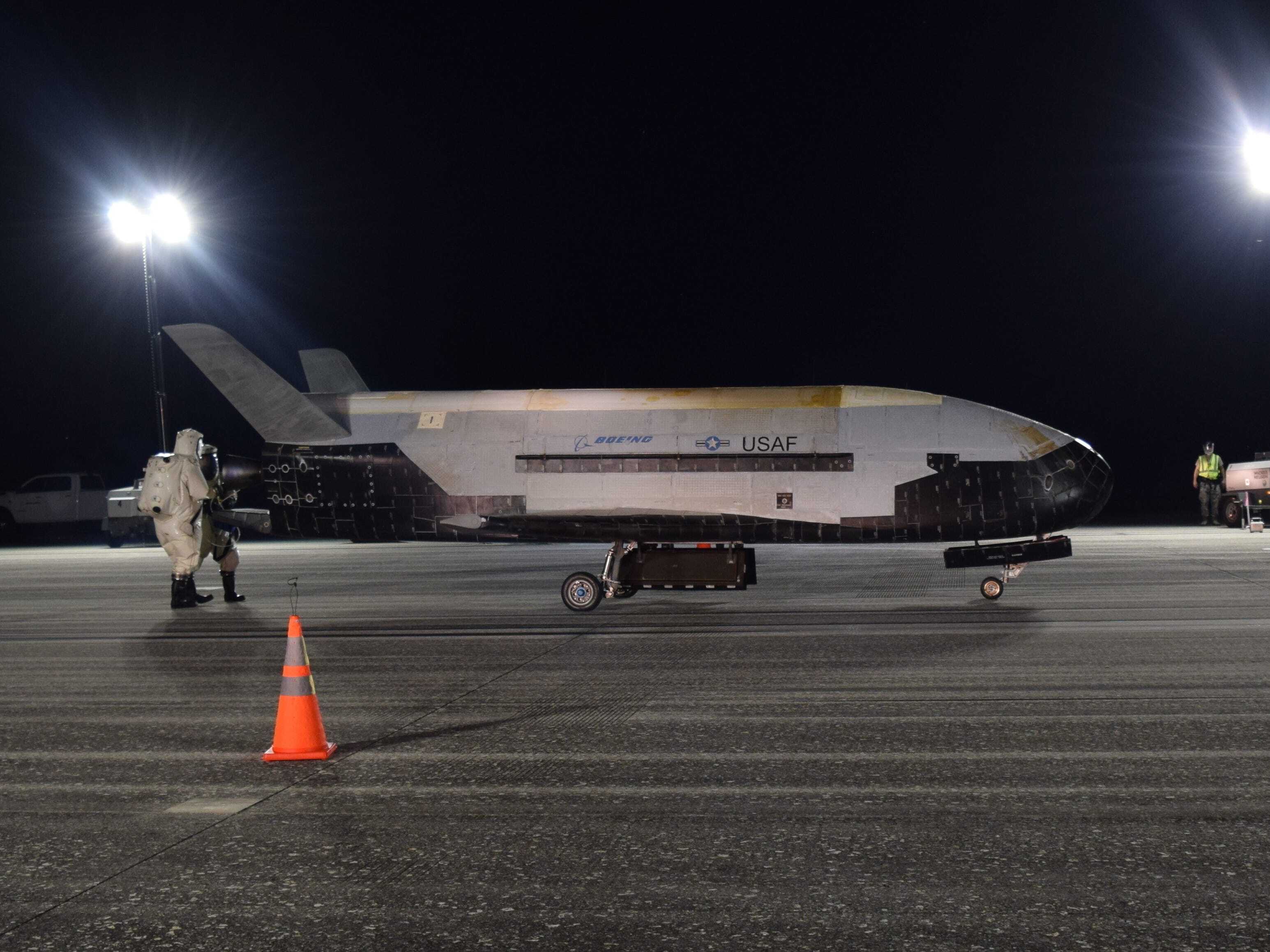
A secretive Space Force spaceplane streaked across Florida early Saturday, generating unmistakable sonic booms en route to a landing at Kennedy Space Center that wrapped up another record-breaking mission.
Dozens of sonic boom reports surfaced as X-37B, a robotic military spacecraft that looks like a miniature space shuttle, followed an eastern path across the state and eventually landed at KSC's Launch and Landing Facility. In a statement, the Space Force confirmed touchdown occurred at 5:22 a.m. EST.
All told, the 30-foot spaceplane spent 908 days in low-Earth orbit, shattering the previous record of 780 days. Its purpose is largely a secret, but the Department of Defense says some of its secondary duties include hosting military research payloads, science experiments, and even NASA investigations.
Though physically small, X-37B has captured countless headlines since its first launch in 2010, mainly due to secrecy but also because of its unprecedented ability to stay in orbit years at a time. It also has the ability to stealthily change its position in orbit.
The spacecraft launches vertically on rockets like United Launch Alliance's Atlas V and SpaceX's Falcon 9, then lands like a plane at KSC. This specific mission, labeled OTV-6, took flight on an Atlas V rocket in May 2020.
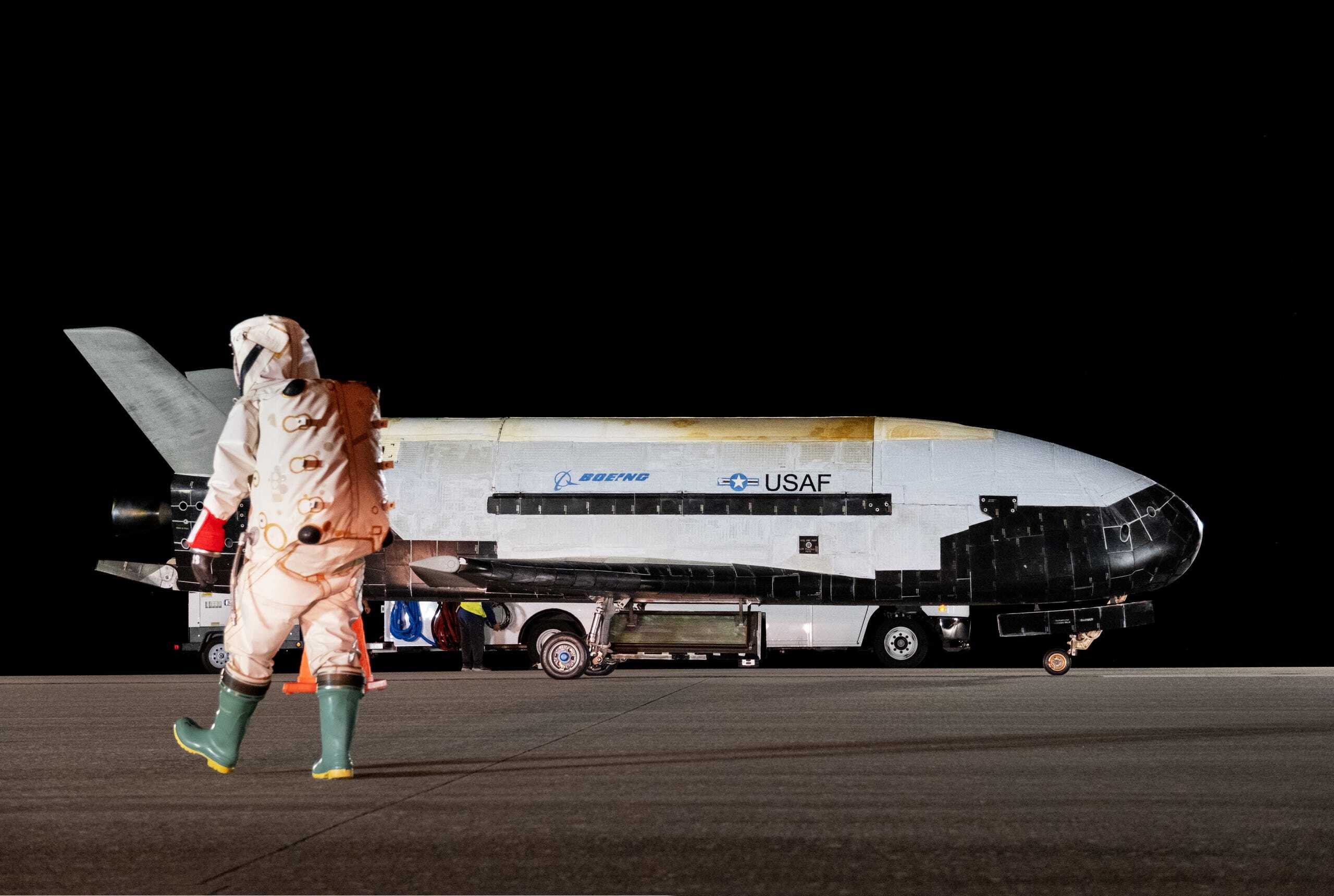
The Space Force's X-37B spaceplane is seen after landing at Kennedy Space Center's Launch and Landing Facility on Saturday, Nov. 12, 2022. The sonic booms generated during its descent were heard throughout Central Florida. Show less STAFF SGT. ADAM SHANKS / SPACE FORCE
"With the successful completion of its sixth mission the reusable spaceplane has now flown over 1.3 billion miles and spent a total of 3,774 days in space," Boeing, which built both X-37Bs in service, said in a statement. "It conducts experiments for government and industry partners with the ability to return them to Earth for evaluation."
Boeing operates an X-37B processing facility next to the Vehicle Assembly Building at KSC, which is only about two miles from the LLF's runway in a straight line. After landing, the spaceplanes are transported to the hangar there, processed, then prepped for liftoff on another rocket.
Some of OTV-6's payloads, according to Boeing and the Space Force, included:
- A new service module to increase the number of payloads carried to orbit.
- An experiment that harnessed solar power and transmitted it back to Earth in the form of microwave energy.
- An opportunity for Air Force Academy cadets to design, build, and deploy a satellite before joining the Space Force.
- And NASA investigations into how space exposure affects materials and seeds, the latter of which could impact how food is grown during long crewed missions.
"The ability to conduct on-orbit experiments and bring them home safely for in-depth analysis on the ground has proven valuable for the Department of the Air Force and scientific community," Lt. Col. Joseph Fritschen, the Space Force's X-37B program director, said in a release. "The addition of the service module on OTV-6 allowed us to host more experiments than ever before.”
Quelle: Florida Today
----
Update: 22.11.2022
.
What was the US military's secret space plane doing on its record-breaking mission?
The uncrewed X-37B space plane touched down at NASA’s Kennedy Space Station on Nov. 12 having spent a record 908 days in orbit
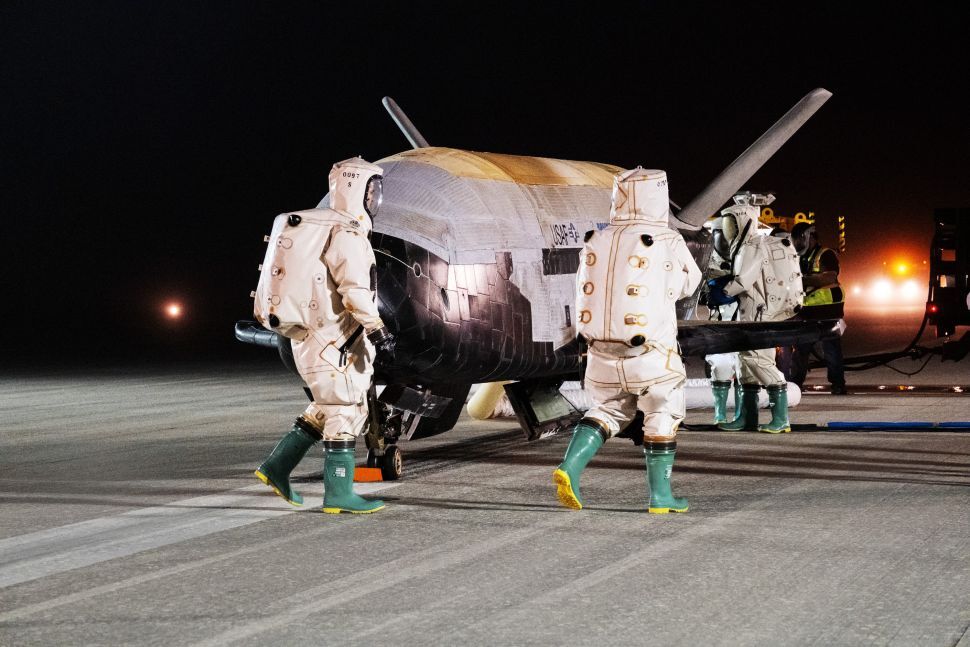
Technicians work with the recently landed robotic X-37B at NASA's Kennedy Space Center in Florida on Nov. 12, 2022. (Image credit: Boeing/US Space Force)
A secret space plane operated by the United States Space Force (USSF) has landed back on Earth after spending a record 908 days in orbit. But what it was doing above our heads remains shrouded in mystery.
The uncrewed X-37B space plane touched down at NASA's Kennedy Space Station on Nov. 12 at 5:22 a.m. ET, concluding the sixth mission that it and another identical vehicle have completed since the first flight in 2010. Details on its activities during the record-smashing trip are sparse, but officials claim it was conducting a number of scientific experiments at around 249 miles (400 kilometers) above Earth.
The X-37B was first designed by Boeing for NASA, before being adapted for use by the U.S military. It is an airplane-spacecraft hybrid that in many ways resembles a miniature space shuttle. For its sixth mission, classified as Orbital Test Vehicle-6 (OTV-6), it was launched vertically while perched atop an Atlas V rocket in May 2020. The space plane has now spent roughly 10 years in orbit across all of its missions, covering approximately 1.3 billion miles (2.1 billion km). The new 908-day flight smashes the 780-day record for a space plane in continuous orbit, which was also set by the X-37B during an earlier mission.
"The X-37B continues to push the boundaries of experimentation, enabled by an elite government and industry team behind the scenes," Lt. Col. Joseph Fritschen, X-37B program director at the Air Force Rapid Capabilities Office, said in a statement(opens in new tab). "The ability to conduct on-orbit experiments and bring them home safely for in-depth analysis on the ground has proven valuable for the Department of the Air Force and scientific community. The addition of the service module on OTV-6 allowed us to host more experiments than ever before."
The United States Space Force has revealed only a few morsels of information(opens in new tab)about the experiments conducted aboard the craft during its most recent flight. These include a test by the U.S. Naval Research Laboratory that successfully harvested light from the sun before beaming it back to Earth as microwaves; and the deployment of an electromagnetically steered training satellite designed by U.S. Air Force cadets. NASA also provided an experiment, called Materials Exposure and Technology Innovation in Space (METIS-2), that researched the effects of space on different materials.
No other details of the experiments on board were revealed, although this hasn’t stopped rivals from engaging in speculation. Dmitry Rogozin, the former head of Russia’s Roscosmos space agency, claimed in an April interview(opens in new tab) with the Russian state-owned news channel Russia-24 that the craft could be being used for spying or for carrying weapons of mass destruction. Chinese military expert and commentator Song Zhongping echoed this sentiment, telling the South China Morning Post(opens in new tab) that the craft’s ability to alter its orbit mid-flight gave it the ability to spy on other satellites or on Earth-based targets, as well as launch attacks from orbit.
"If the X-37B can be loaded with small satellites, it can also be loaded with weapons. It may also be able to be fitted with robotic arms to capture other satellites that are in orbit," Song said.
Former Pentagon official Heather Wilson has also remarked on the craft’s ability to alter its orbit, a capability she said was due to the significant drag generated by its low Earth orbit.
"Which means our adversaries don't know — and that happens on the far side of the Earth from our adversaries — where it's going to come up next," Wilson said at the Aspen Security Forum in 2019(opens in new tab). "And we know that that drives them nuts. And I'm really glad about that."
China also has a secret space plane, which was launched into orbit from a Long March 5B rocket on Aug. 4. Much like the X-37B, much of what it is doing in orbit is unknown.
Quelle: SC
